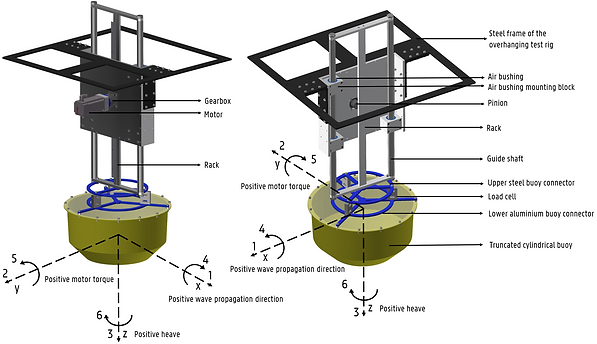案例分析



Breaking Waves of Progress: Experimental Testing of Wave Energy Converters equipped with OAV Air Bushings
Wave energy is a renewable form of energy which is largely untapped. Wave energy converters (WECs) are devices designed to harness this energy source and convert it to electricity. The last decades a considerable effort has been made by industry and academia to bring WECs to a commercial stage. There is a need for available real-life data to validate numerical models in the wave energy sector. However, publicly available databases from WEC array experiments are limited due to the high cost and complexity of conducting such experiments. The ‘WECfarm’ project, initiated by Ghent University, aims to improve the understanding of interactions between the individual WECs within an array, and address the need for experimental data on WEC array tests. A team from the Coastal Engineering Research Group of Ghent University, Belgium performed experiments focused on the extraction of wave energy using an array of five point absorber WECs. Similar to offshore wind turbines, multiple point absorber WECs will be installed in an array configuration, to increase the total capacity, and to benefit from the economies of scale. Whereas wind turbines always interact destructively due to wake effects, WECs can interact constructively, since hydrodynamic interactions between the WECs occur through radiation and diffraction of waves, changing the direction of the incoming wave energy.
The point-absorber ‘WECfarm’ WEC consists of a floating buoy to capture energy from waves coming from different directions. The WECs are equipped with a permanent magnet synchronous motor (PMSM), addressing the need for WEC array tests with an accurate and actively controllable Power Take-Off (PTO). The WEC array control and data acquisition are realized with a Speedgoat real-time target machine, offering the possibility to implement advanced WEC array control strategies in the MATLAB-Simulink environment.
The team emphasized the significance of OAV Air Bushings in the context of WECs to exclude unwanted friction in the linear guiding system. The surge wave excitation force yields a moment on the linear guiding system. This moment can be decoupled in normal forces by a configuration of three air bushings. The air bushings are characterized by a load versus pressure curve, where one 40 mm OAV air bushing can cope with a maximum radial load of 720 N, for a nominal pressure of 5.5 bar. A configuration of three OAV 40 mm air bushings guarantees a permanent layer of air between the guide shafts and the bushings for the most extreme wave conditions, resulting in zero-friction linear guiding on the condition of a proper alignment. To obtain the air gap, a compressor with a two-stage air filter supplies these air bushings with clean and dry air under a nominal pressure of 5.5 bar. The OAV 40 mm air bushings require a shaft's outside diameter of 40.00 mm +0.00/-0.02 mm (tolerance class g6). Figure 1 shows a rendering of a single ‘WECfarm’ WEC, and Figure 2 shows a schematic of the data acquisition and control flow.

Figure 1. Rendering of the ‘WECfarm’ WEC used within the experimental campaign. The OAV Air Bushings are placed within the mounting blocks for axial frictionless motion along the guide shafts in the heave direction.

Figure 2. Schematic of the transmission of input and output for the `WECfarm' five-WEC array. The real-time control model relays information to the target machine. Each WEC has sensors that also transmit information.
The OAV Air Bushings are pivotal components in the design of the ‘WECfarm’ WEC, as the experiments target high quality data with low uncertainties. The air bushings exclude the variability in mechanical losses and energy dissipation associated with traditional bearing systems, as for example ball or plain bearings. Additionally, the use of air bushings enhance the controllability and responsiveness of the WEC system, allowing for more precise and efficient power capture from the waves. The team opted for OAV air bushings due to superior pricing, quality, and technical support during the project.
The experimental setup was tested in the Coastal & Ocean Basin Ostend, Belgium, which is a wave basin with an L-shaped wavemaker of 20 by 20 m. Figure 3 and 4 show the experimental setup of the five-WEC array at the wave basin. To maximize power absorption, a control system tailored to the WEC array needs to be implemented. Control strategies aim to achieve resonance by altering the dynamics of the WEC system, as most power is produced during resonant absorption. The research team investigated how the WEC array layout should be optimized simultaneously with the applied control strategy to maximize the power absorption. System identification tests were executed to obtain an accurate dynamic model of the WEC array. Proportional (resistive) and Proportional-Integral (reactive) controllers were designed and tested accordingly.

Figure 3. Experimental setup of the five-WEC array at the Coastal & Ocean Basin Ostend, Belgium. The WECs are attached to a truss structure placed centrally in the wave basin.

Figure 4. Detailed view of the experimental setup of the five-WEC array at the Coastal & Ocean Basin Ostend, Belgium. A configuration of three air bushings on each WEC is used for the linear guiding in the heave direction.

______________________________
Vervaet, T., Stratigaki, V., De Backer, B., Stockman, K., Vantorre, M., & Troch, P. (2022). Experimental modelling of point-absorber wave energy converter arrays : a comprehensive review, identification of research gaps and design of the WECfarm setup. Journal of Marine Science and Engineering, 10(8). https://doi.org/10.3390/jmse10081062
Vervaet, T. (2023). Experimental modelling of point absorber wave energy converter arrays with control design based on impedance matching. Ghent University. Faculty of Engineering and Architecture, Ghent, Belgium.
This material is based on work supported by the Coastal Engineering Research Group of the Department of Civil Engineering of Ghent University.